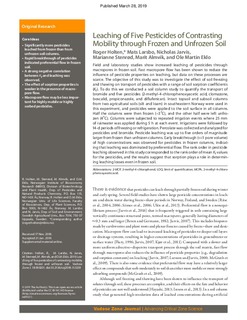| dc.contributor.author | Holten, Roger | |
| dc.contributor.author | Larsbo, Mats | |
| dc.contributor.author | Jarvis, Nicholas | |
| dc.contributor.author | Stenrød, Marianne | |
| dc.contributor.author | Almvik, Marit | |
| dc.contributor.author | Eklo, Ole Martin | |
| dc.date.accessioned | 2019-12-09T13:54:43Z | |
| dc.date.available | 2019-12-09T13:54:43Z | |
| dc.date.created | 2019-05-09T10:10:26Z | |
| dc.date.issued | 2019 | |
| dc.identifier.citation | Vadose Zone Journal. 2019, 18 (1), . | nb_NO |
| dc.identifier.issn | 1539-1663 | |
| dc.identifier.uri | http://hdl.handle.net/11250/2632339 | |
| dc.description.abstract | Field and laboratory studies show increased leaching of pesticides through macropores in frozen soil. Fast macropore flow has been shown to reduce the influence of pesticide properties on leaching, but data on these processes are scarce. The objective of this study was to investigate the effect of soil freezing and thawing on transport of pesticides with a range of soil sorption coefficients (Kf). To do this we conducted a soil column study to quantify the transport of bromide and five pesticides (2-methyl-4-chlorophenoxyacetic acid, clomazone, boscalid, propiconazole, and diflufenican). Intact topsoil and subsoil columns from two agricultural soils (silt and loam) in southeastern Norway were used in this experiment, and pesticides were applied to the soil surface in all columns. Half the columns were then frozen (−3°C), and the other half were left unfrozen (4°C). Columns were subjected to repeated irrigation events where 25 mm of rainwater was applied during 5 h at each event. Irrigations were followed by 14-d periods of freezing or refrigeration. Percolate was collected and analyzed for pesticides and bromide. Pesticide leaching was up to five orders of magnitude larger from frozen than unfrozen columns. Early breakthrough (<<1 pore volume) of high concentrations was observed for pesticides in frozen columns, indicating that leaching was dominated by preferential flow. The rank order in pesticide leaching observed in this study corresponded to the rank order of mean Kf values for the pesticides, and the results suggest that sorption plays a role in determining leaching losses even in frozen soil. | nb_NO |
| dc.language.iso | eng | nb_NO |
| dc.rights | Attribution-NonCommercial-NoDerivatives 4.0 Internasjonal | * |
| dc.rights.uri | http://creativecommons.org/licenses/by-nc-nd/4.0/deed.no | * |
| dc.subject | 2-MCP | nb_NO |
| dc.subject | 2-methyl-4-chlorophenol | nb_NO |
| dc.subject | LOQ | nb_NO |
| dc.subject | Lmit of quantification | nb_NO |
| dc.subject | MCPA | nb_NO |
| dc.subject | 2-methyl-4-chlorophenoxyacetic acid | nb_NO |
| dc.title | Leaching of Five Pesticides of Contrasting Mobility through Frozen and Unfrozen Soil | nb_NO |
| dc.type | Journal article | nb_NO |
| dc.type | Peer reviewed | nb_NO |
| dc.description.version | publishedVersion | nb_NO |
| dc.rights.holder | © 2019 The Author(s). | nb_NO |
| dc.subject.nsi | VDP::Landbruks- og Fiskerifag: 900 | nb_NO |
| dc.source.pagenumber | 10 | nb_NO |
| dc.source.volume | 18 | nb_NO |
| dc.source.journal | Vadose Zone Journal | nb_NO |
| dc.source.issue | 1 | nb_NO |
| dc.identifier.doi | 10.2136/vzj2018.11.0201 | |
| dc.identifier.cristin | 1696550 | |
| dc.relation.project | Norges forskningsråd: 244526 | nb_NO |
| cristin.unitcode | 7677,3,0,0 | |
| cristin.unitname | Divisjon for bioteknologi og plantehelse | |
| cristin.ispublished | true | |
| cristin.fulltext | original | |
| cristin.qualitycode | 1 | |

